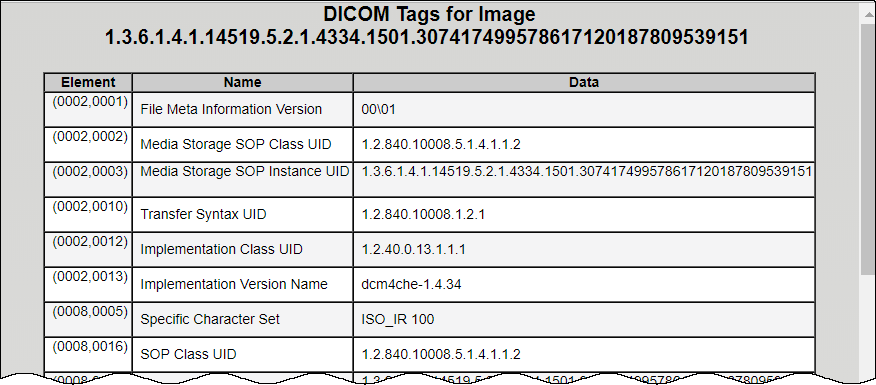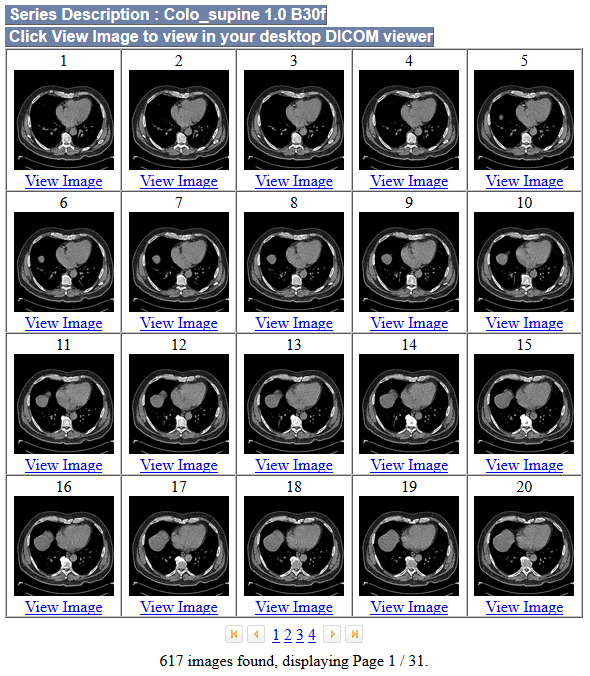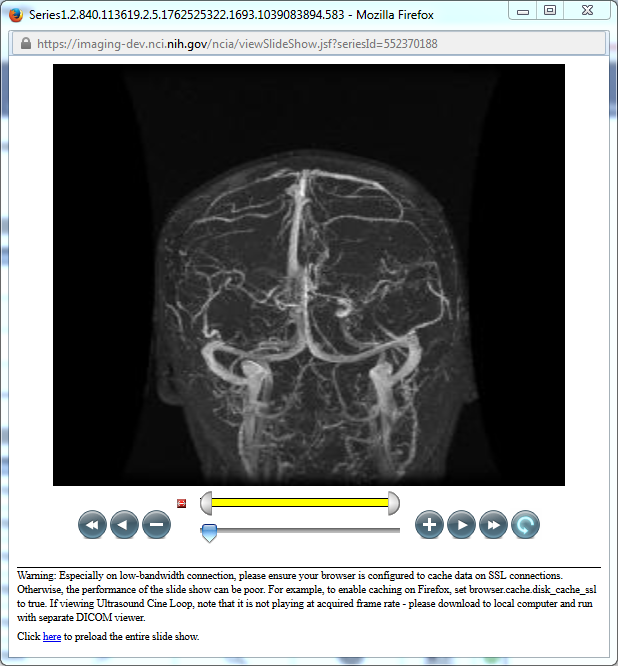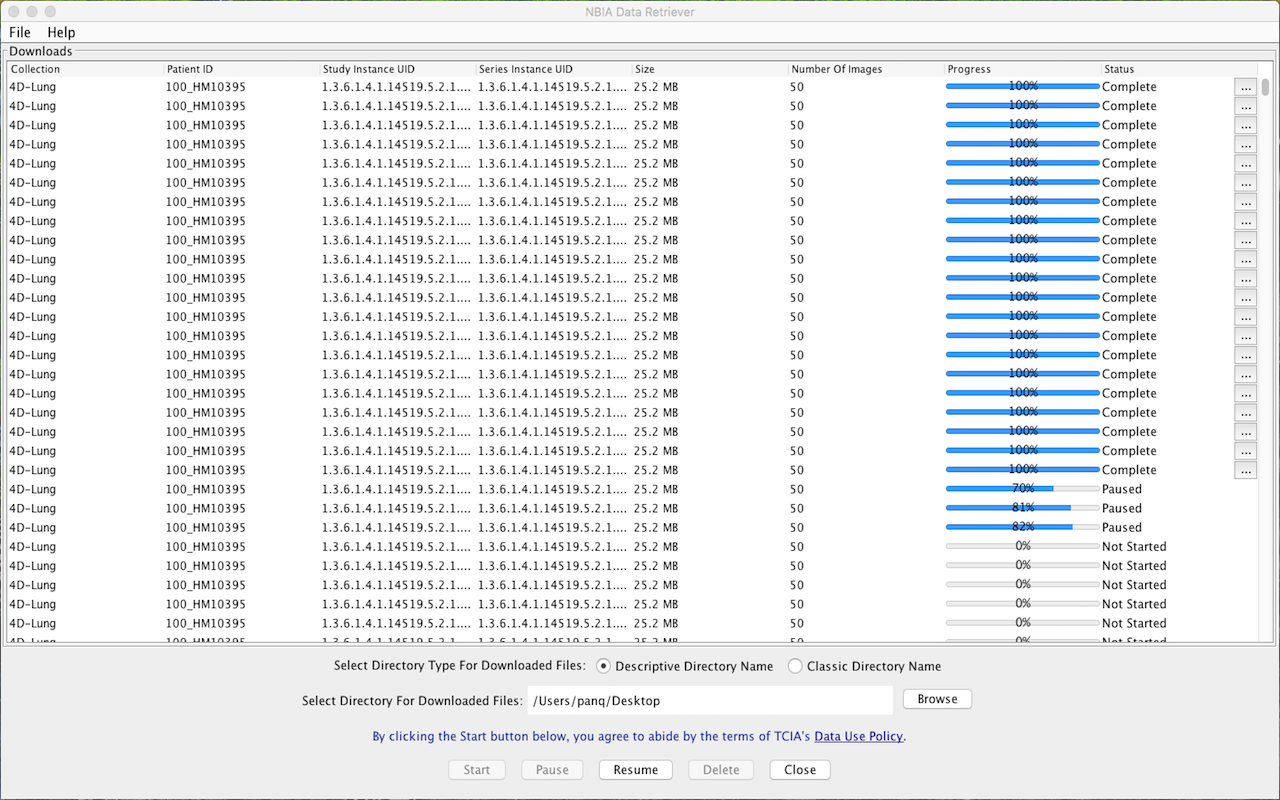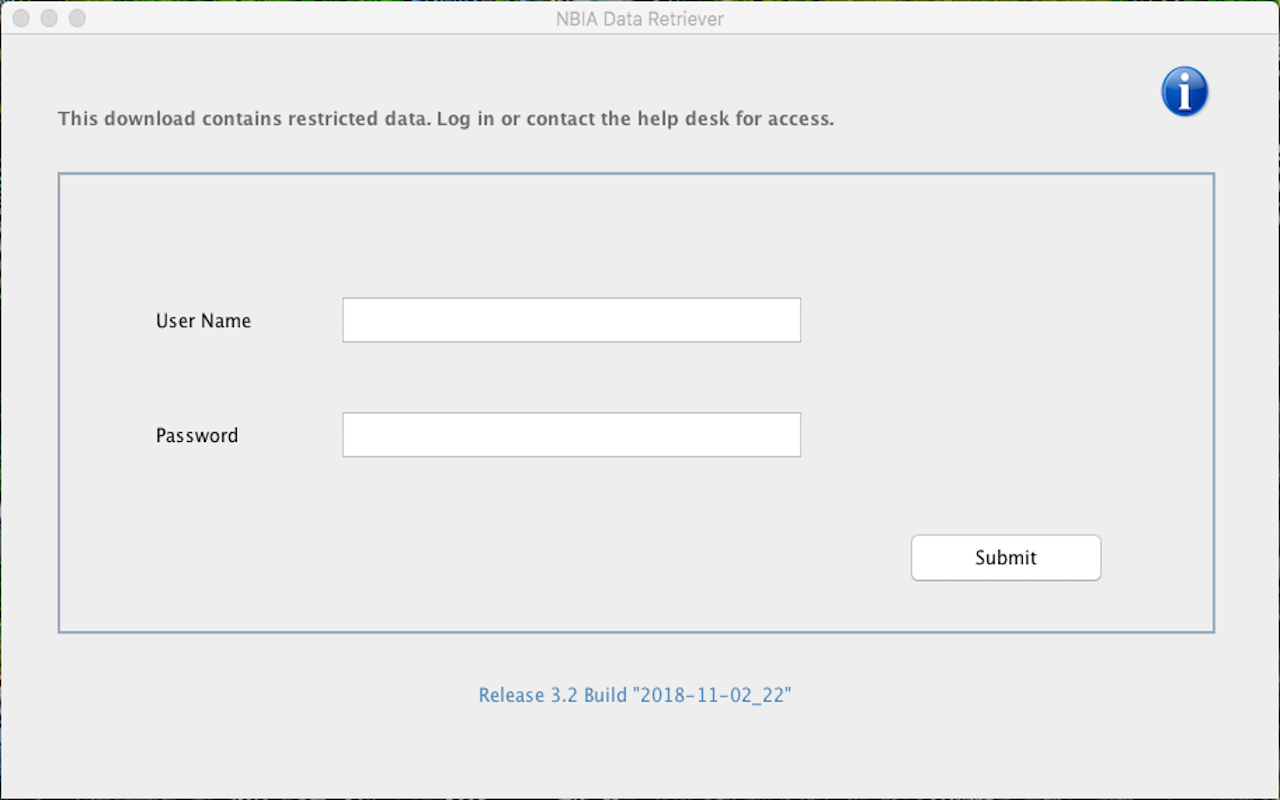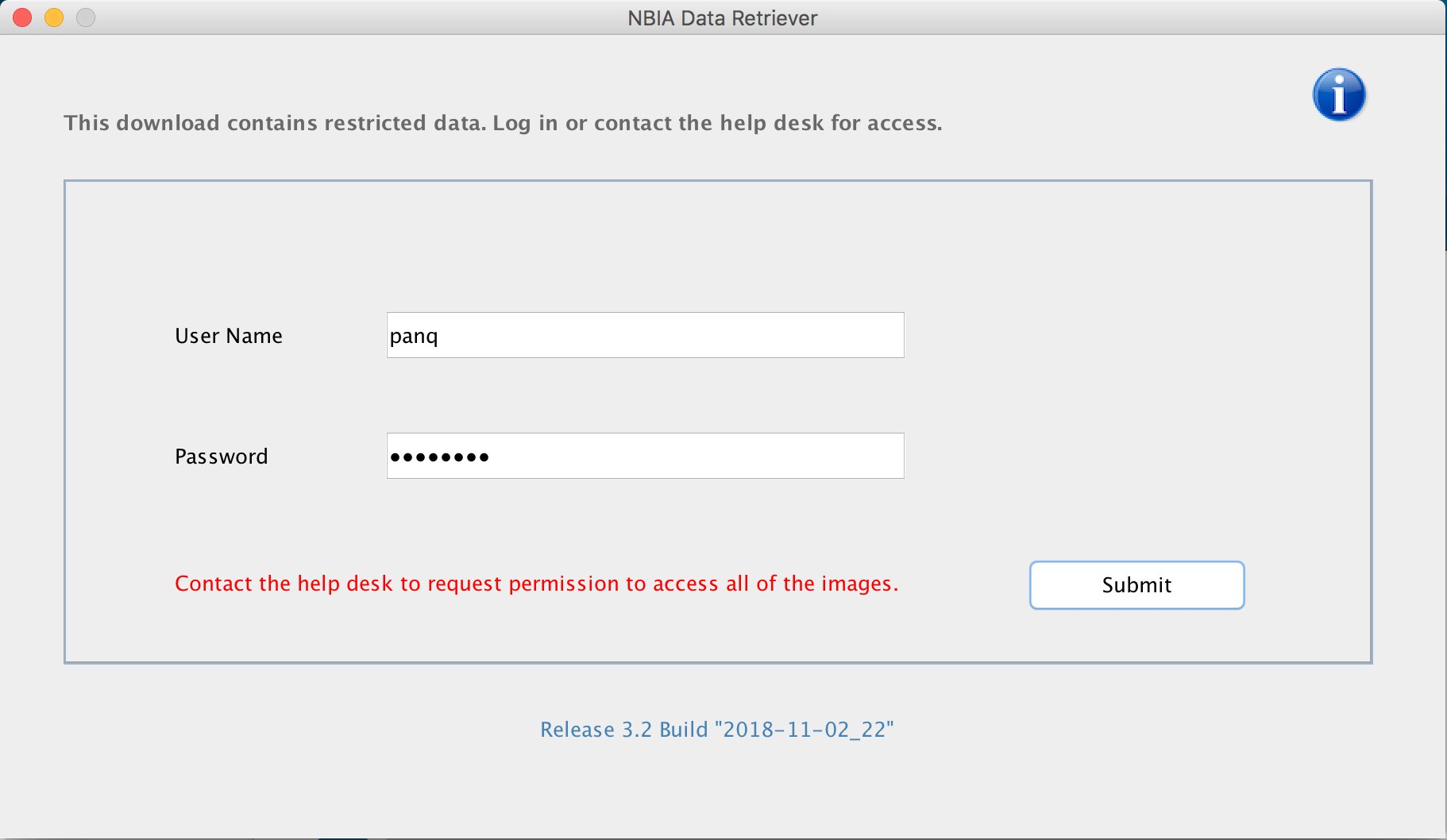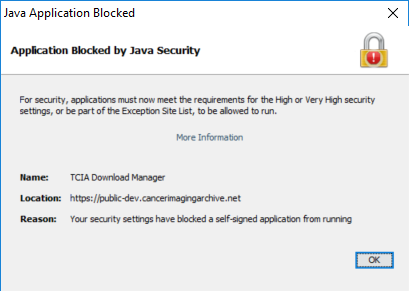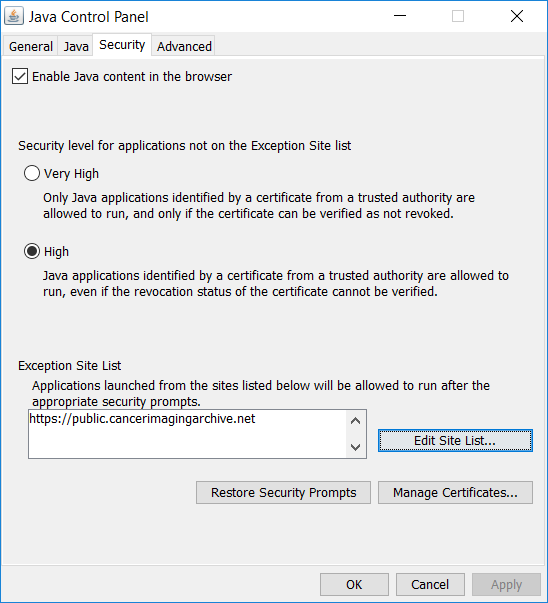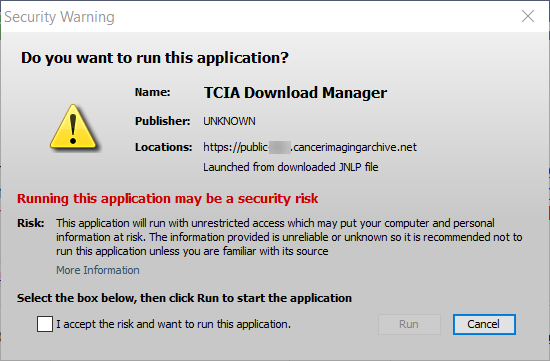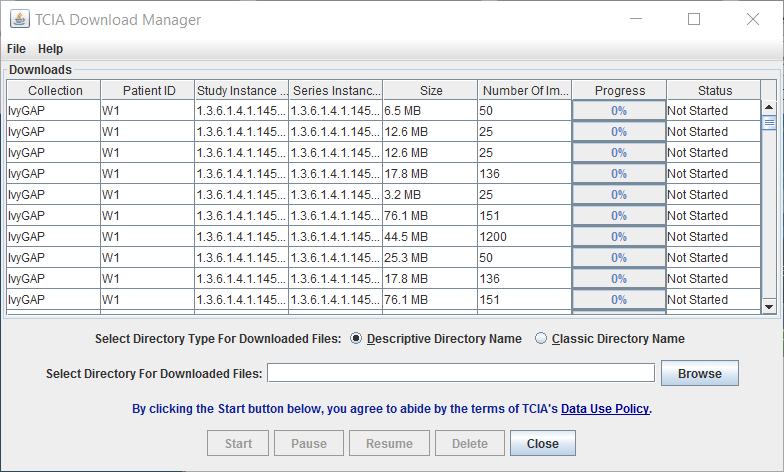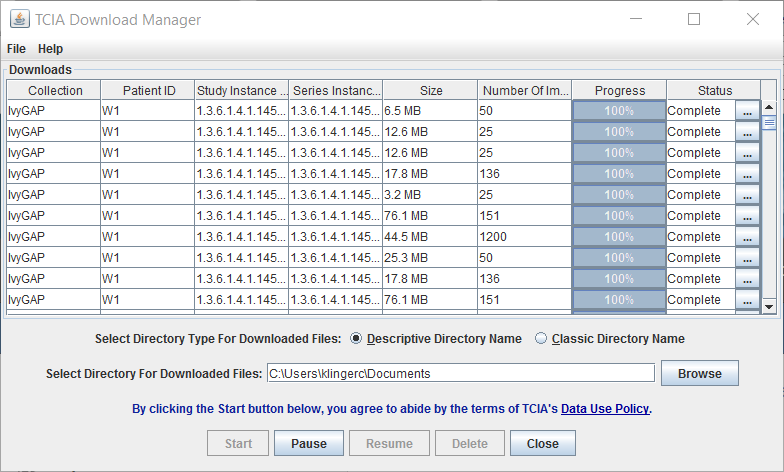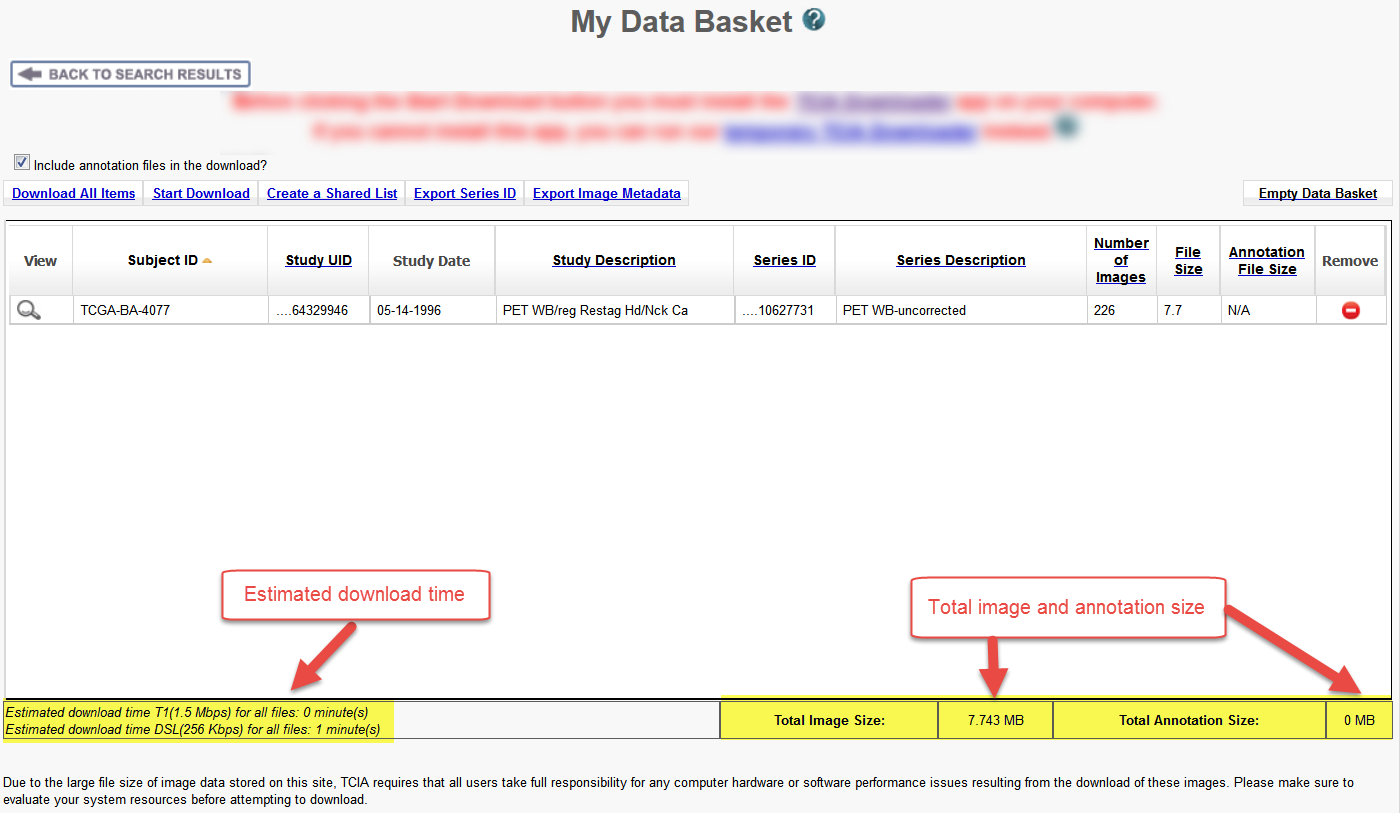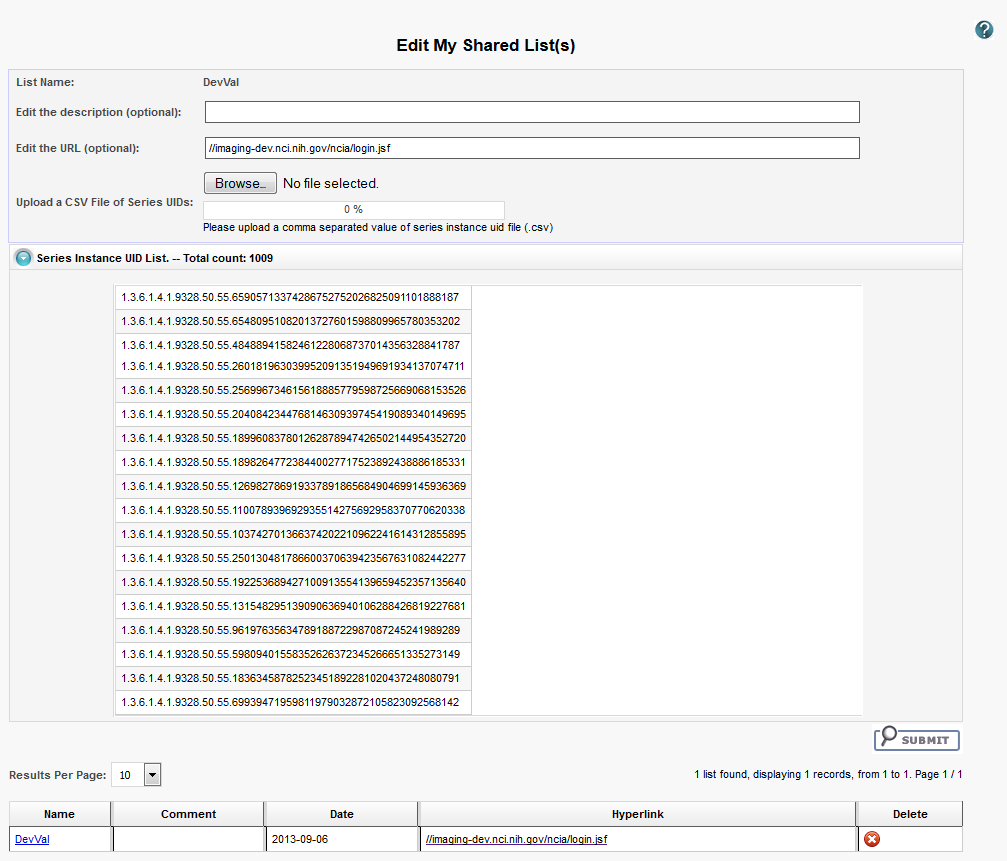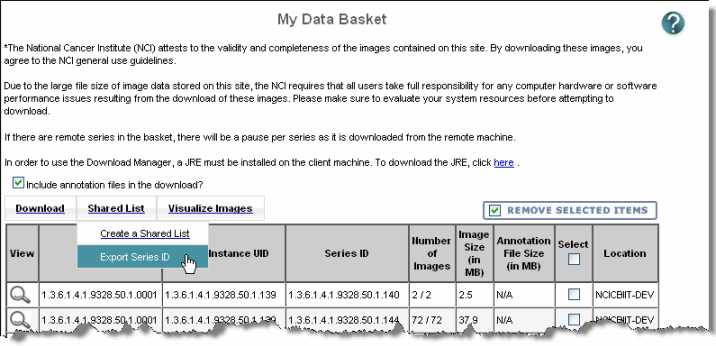This chapter describes how to review the results of NBIA database searches.
Topics in this chapter include:
Search Results Overview
In reviewing search results, it is important to review the hierarchy of submissions in NBIA.
Collection > Patient (Subject) > Study > Series > Images |
A Simple Search, Text Search, and Advanced Search each orders search results by Subject ID on the Search Results (by Subject) page. Clicking that Subject ID displays the studies and image series matching the search criteria for that subject. For more information, see Search Results (Studies for Subject).
You can view images associated with studies for the selected subject in various ways, including:
- viewing all study images in a DICOM web viewer,
- viewing thumbnails of all study images on the Search Results (Images for Series) page
- viewing selected images in your desktop DICOM viewer,
- viewing all study images in a cine loop,
- or viewing the DICOM header of the first image in the series.
Retrieving objects for download
At any point in the process of reviewing results, you can add items - all data pertaining to a patient, study, or an image series - to your data basket. When items are in your data basket, you must take a subsequent step to download them.
When you download a series that has annotation files (indicated by Yes in the Contains Annotations column), they are automatically downloaded as well.
Search Results (Studies for Subject)
The following table describes the data available for each study and image series in that study.
Field | Description |
|---|---|
| DICOM Web Viewer link | Click this link to see all study images in the DICOM Web Viewer. |
Series | Series identification number |
Description | Description of the series |
Modality | Image modality |
Manufacturer | Name of the manufacturer of the image series |
Images | Displays the number of images in the series. This number includes visible images that meet the search criteria. |
| Thumbnails | Click this link to display thumbnails of the series' images. For more information, see Search Results (Images for Series). |
| Cine Mode | Click in a series record to launch an animation of the series. This feature is only available when two or more thumbnails are available for the series. For more information, see Viewing Image Animation. |
| DICOM | Click to open a new window that displays DICOM metadata about the first image in the series.
|
Add to Basket |
For more information, see Managing the Data Basket. |
| Add a Study series to Basket | To add only the series in a single study in the search results to your basket, click in the Add This Study to Basket section. |
Search Results (Images for Series)
Click View Image under any thumbnail to save the image as a file or open it in the DICOM viewer.
Viewing Image Animation
- On the Search Results (Studies for Subject) page, you can launch an animation of thumbnails if there is more than one image in the series. Click in a series record in the search results.
OR - You can launch the animation of an image series from the data basket. In the View column of the data basket, click the magnifying glass symbol,, corresponding to the series you want to view. On the View Series Images page, click the View Series in Cine Mode link.
When the viewer opens (figure above), the animation controls display below the image. When you use the controls, NBIA proceeds to display the images sequentially, like a movie.
The following table describes the action of each of the animation controls.
Animation Controls | Action |
|---|---|
| Reset start and end. | |
Drag ends of the yellow bar to vary the range of images playing. | |
Click to return to the first image in the set. | |
Click to play animation backward through the series. | |
| Click to stop the animation; click again to display one image at a time, moving backward through the series. | |
Drag the arrow to set which frame of the movie displays. This also monitors the progress of the animation. | |
Click to stop the animation; click again to display one image at a time, moving forward through the series. | |
Click to play animation forward through the series. | |
Click to progress to the last image in the set. | |
Click to cycle the animation forward or backward. Once set, the animation continues. |
Tip
If the animation is very sluggish, you may want to preload the entire animation by clicking the link at the bottom of the series animation page. Also heed the note at the bottom of the page, which reads:
Warning: Especially on low-bandwidth connection, please ensure your browser is configured to cache data on SSL connections. Otherwise, the performance of the slide show can be poor. For example, to enable caching on Firefox, set browser.cache.disk_cache_ssl to true. If viewing Ultrasound Cine Loop, note that it is not playing at acquired frame rate - please download to local computer and run with separate DICOM viewer.
Obtaining DICOM Viewers
Most image data and some associated data within NBIA is stored in DICOM format. There are a variety of both open source and commercial DICOM tools that could be used to manipulate and view these files. While NBIA does not endorse nor recommend any particular tool, here is a list of tools that we or our partners have used in our daily work. More information about DICOM is available.
Select Tools > List DICOM Image Viewers to open a page of selected links to freeware DICOM image viewers. This list is provided for your convenience. Many other DICOM viewers are available on the internet. This is not an endorsement of the listed viewers.
Before using the viewers
The images in this image repository need to be downloaded before you can view them using the viewers.
- ImageJ runs on Linux, Mac OS 9, Mac OS X, Windows, and the Sharp Zaurus PDA.
- FusionViewer open source & multiplatform PET/CT display software package
- OSIRIX (MAC OSX)
- AIM on ClearCanvas
- 3D Slicer
- MATLAB dicomread function and MATLAB dicominfo function (headers)
Downloading NBIA Images
Downloading the NBIA Data Retriever
The most convenient method of downloading is by using the NBIA Data Retriever. You must install the NBIA Data Retriever before you begin downloading. You only have to install it once to use it in future downloading sessions.
Consult the NBIA Data Retriever FAQ for more information about NBIA Data Retriever versions and usage.
| Platform | File |
|---|---|
| Windows | |
| Mac | |
| Linux (tested on CentOS) | NBIADataRetriever-4.4.1.x86_64.rpm To run this file, type the following at the command prompt: |
| Linux (tested on Ubuntu) | To run this file, type the following at the command prompt:
|
The following new and updated features are available in NBIA Data Retriever 4.3, which was released in April 2021.
April 2022
- Any version of the NBIA Data Retriever that is below the minimum version configured on the server or has an unknown version will be prompted to upgrade to the latest version.
- A resume downloading feature is now part of the command line interface (CLI) of the app.
- The policy window is read-only.
Installing the NBIA Data Retriever
To install the NBIA Data Retriever on Windows
- Download the installer package for Windows using the link above.
- Save the installer package file to your computer.
- Install the app by double-clicking the installer package file.
- Agree to the terms in the License Agreement and click Install.
- When the Setup Wizard ends, click Finish.
To install the NBIA Data Retriever on Mac
The Mac version of the NBIA Data Retriever is only available through the Mac App Store. It requires a manifest file to work. You can download the app first or create a manifest file first. If you download the app first, right-click the manifest file and select Open With NBIA Data Retriever. If you create a manifest file first, right-click it and select Open With App Store. This installs the app and then opens the manifest file in the app.
On your Mac, find the NBIA Data Retriever on the Mac App Store.
The NBIA Data Retriever is free but still requires you to log in to download it. Consider changing your macOS Password Settings so that you can download free software without having to log in separately for it.
- Click Get, then click Install App. The NBIA Data Retriever is free.
The app starts downloading to your Mac. When the download is complete, you can open a manifest file with the NBIA Data Retriever.
To install the NBIA Data Retriever on Linux (centOS or Ubuntu)
You must have the sudo privilege on your computer and a sudo password to install the NBIA Data Retriever on CentOS and Ubuntu.
- Download the installer package for centOS or Ubuntu using the links above.
- Save the installer package file to your computer.
- Open a command window and go to the location where you saved the installer.
- For a centOS system, enter the following at the command prompt:
sudo yum -v -y remove TCIADownloader.x86_64;sudo yum -y install NBIADataRetriever-3.3-1.x86_64.rpm - For an Ubuntu system, enter the following at the command prompt:
sudo -S dpkg -r tciadownloader;sudo -S dpkg -i nbia-data-retriever-3.3.deb
Enter the sudo password when prompted.
- For a centOS system, enter the following at the command prompt:
Downloading Images Using the NBIA Data Retriever
When you start downloading the images you have added to the data basket, NBIA provides a list of those images in a manifest file (manifest-xxx.tcia). You must have already installed the NBIA Data Retriever to open this manifest file and download the images.
You can share the manifest file with collaborators so that they can download the same images that you have added to your data basket. Collaborators must also install the NBIA Data Retriever to open the manifest file.
If you want to share a manifest file that includes links to private image collections, you must first manually install the latest NBIA Data Retriever. The latest version of the NBIA Data Retriever controls access to private collections. In addition, your collaborators must have the same access to those private collections as you do. Otherwise, your collaborators will not be able to download images from those collections.
- Search for images of interest.
- Add those images to your data basket.
- Open the My Data Basket page and click Start Download.
Click the
manifest-xxx.tciafile.
If you are only downloading public images, the NBIA Data Retriever appears, listing the items in your data basket. If you are downloading any private images, see the section about downloading private data.The NBIA Data Retriever lists all items you selected in the data basket. You can hover your mouse over the Patient ID, Study Instance, and Series Instance columns to reveal the complete corresponding IDs. You can also resize a column by selecting and dragging the column border.
If you do not want to download any of those items, select them in the Downloads table and then click Delete. When you remove an item from the Downloads table, it stays in your data basket.
Click Browse to navigate to the destination where you want the images/annotations to be downloaded.
Click Start to begin the download. You can monitor the download in the Progress column. The Status column indicates when the download for each item is complete.
At any point in the process, you can click the Pause and Resume buttons to temporarily stop and restart the process.
Note that files downloaded this way are not compressed. The downloaded files are stored in a child folder under the destination folder such as
Collection Name > Patient ID > part of Study Date + part of Study ID + part of Study Description + last 5 digits of Study Instance UID > part of Series Number + part of Series Description + last 5 digits of Series Instance UID.Network Error?
If network errors occur during large downloads, the NBIA Data Retriever retries the files the number of times that your administrator has configured.
Downloading Private Data
If you are downloading any private data, you are prompted to log in.
Once you log in, the NBIA Data Retriever appears.
If you do not have permission to access even one of the collections/sites to which the images you have in your manifest file, you are prompted to contact the help desk to request permission to access all of the images.
Using the TCIA Download Manager
However, if you cannot download the application, the alternative is to use the TCIA Download Manager, a Java Network Launch Protocol (JNLP) file.
The TCIA Download Manager allows you to replicate items in your Data Basket, downloading them to your local machine. It is a Java program and requires that you install a Java Runtime Environment (JRETM) on your machine to run it. You can download the JRE . The TCIA Download Manager does not limit the total size of the download.
JRE
You must have version 8 or higher of the Java Runtime Environment (JRE) installed to be able to open the TCIA Download Manager.
- If JRE 8 is installed, the TCIA Download Manager attempts to start. To run the application, you must click Run in the Warning dialog box indicating the application's digital signature cannot be verified. Before doing so, you can select the More Information... link at the bottom of the dialog to view a more detailed report of any security issues. Then you can evaluate whether you want to run the application.
- If JRE is installed but the version is older than version 6, the browser automatically attempts to upgrade the JRE to version 8.
If the JRE is not installed, when you click the Download Manager button, the browser prompts you for what it should do with the JNLP file. The My Data Basket page includes a link to a page where you can download the JRE.
If the TCIA Download Manager fails to work properly, this could be a JRE version issue. The TCIA Download Manager has been tested successfully with Version 8 Update 101.
Java Security settings
Java Security may block the installation of the TCIA Download Manager. You may see a window like the following.
To resolve this issue, do the following.
- Select Start menu > Configure Java.
The Java Control Panel appears. - Select the Security tab.
- Click Edit Site List and then enter https://imaging.nci.nih.gov as the location.
- Click OK.
- Click the JNLP file to run the TCIA Download Manager again.
A message window appears, asking you if you want to run this application. - Select I accept the risk and want to run this application.
- Click Run.
The TCIA Download Manager successfully launches.
Removing items
The TCIA Download Manager initially lists everything in your data basket. You can remove items from the Downloads list in the TCIA Download Manager that you do not want to download. When you remove an item from the list, it remains in the data basket. You just do not download it.
To download objects using the TCIA Download Manager
Mac OS X
The following instructions apply to Windows PCs but you can also use the TCIA Download Manager on Mac OS X .
- At the top of the My Data Basket page, click the Temporary TCIA Downloader link. You are prompted to open or save the TCIA Download Manager. Open it in the JRETM you installed. If you have any issues opening the TCIA Download Manager, see the note about Java Security settings.
The page lists all items you selected in the data basket. You can hover your mouse over the Patient ID, Study Instance, and Series Instance columns to reveal the complete corresponding IDs. You can also resize a column by selecting and dragging the column border. - Click Browse to navigate to the destination where you want the images/annotations to be downloaded.
Click Start to begin the download. You can monitor the download in the Progress column. The Status column indicates when the download for each item is complete.
At any point in the process, you can click the Pause and Resume buttons to temporarily stop and restart the process.
Note that files downloaded this way are not compressed. The downloaded files are stored in a child folder under the destination folder such as
Collection name/patient id/study instance UID/series instance UID/image SOP instance UID.
Removing items
The TCIA Download Manager initially lists everything in your data basket. You can remove items from the Downloads list in the TCIA Download Manager that you do not want to download. When you remove an item from the Downloads list, it remains in the data basket. You just do not download it.
Network error?
Creating Manifest Files
Creating a Manifest File Using NBIA
To use the NBIA Data Retriever, you must already have a manifest file that lists the files you want to download. You create the manifest file by searching the data portal of NBIA. After installing the NBIA Data Retriever, double-click this manifest file to invoke the application.
Double-clicking the NBIA Data Retriever icon alone does not invoke the NBIA Data Retriever.
To create a manifest file:
- Search for images of interest.
- Add those images to your data basket.
- Open the My Data Basket page and click Start Download.
A manifest file is created and downloaded to your computer.
- If you have already installed the NBIA Data Retriever, double-click the manifest file to open it using the NBIA Data Retriever. Click Open when your web browser prompts you to open the file.
- If you want to use this manifest file to download images more than once or download images you select on other machines, click Save at the web browser prompt. You can then double-click the saved manifest file in Windows Explorer on Windows, Finder on Mac, or File Manager on Linux to invoke the NBIA Data Retriever.
Creating a Manifest File Using the Manifest API
Refer to the Manifest API documentation for instructions on how to use the API. The outcome of the REST API call must be saved as a text file with the extension .tcia.
Example Manifest Query
curl -H "Authorization:Bearer d98c390f-b53d-4456-beb3-110e63663762" -k "http://localhost:8080/nbia-api/services/getManifestTextV2" -d "list=1.3.6.1.4.1.9328.50.3.336&includeAnnotation=false"
The API returns text that can be used as a manifest file for the NBIA Data Retriever.
downloadServerUrl=https://imaging-devcm.nci.nih.gov/nbia-download/servlet/DownloadServlet includeAnnotation=false noOfrRetry=4 databasketId=manifest-1523866570303.tcia manifestVersion=3.0 ListOfSeriesToDownload= 1.3.6.1.4.1.9328.50.3.336
Creating a Manifest File Using the Shared List API
If you have a shared list, you can use the Shared List Query API to create a manifest file. Refer to the Shared List Query API documentation for instructions on how to use the API.
Example Manifest from Shared List Query
curl -H "Authorization:Bearer a99171a1-b289-4700-9e4e-1bd73ce1bbb5" -k "http://localhost:8080/nbia-api/services/getManifestTextFromSharedList" -d "sharedList=scottslist&includeAnnotation=false"
The API returns text that can be used as a manifest file for the NBIA Data Retriever.
downloadServerUrl=https://imaging-devcm.nci.nih.gov/nbia-download/servlet/DownloadServlet includeAnnotation=false noOfrRetry=4 databasketId=manifest-1523866570303.tcia manifestVersion=3.0 ListOfSeriesToDownload= 1.3.6.1.4.1.9328.50.3.336
Creating a Manifest File Using the JNLP Data Query API
If you have a JNLP file, you can use the JNLP Data Query API to create a manifest file. Refer to the JNLP Data Query API documentation for instructions on how to use the API.
Example Manifest from JNLP Data Query
curl -H "Authorization:Bearer 3b2bf812-a97e-454e-af94-623b868a2955" -k "http://localhost:8080/nbia-api/services/getManifestFromJNLPFileData" -d "jnlpArgument=C:\Apps\nbia\apache-tomcat-7.0.68\temp\jnlp-data1521628213301.txt&includeAnnotation=false"
The API returns text that can be used as a manifest file for the NBIA Data Retriever.
downloadServerUrl=https://imaging-devcm.nci.nih.gov/nbia-download/servlet/DownloadServlet includeAnnotation=false noOfrRetry=4 databasketId=manifest-1523866570303.tcia manifestVersion=3.0 ListOfSeriesToDownload= 1.3.6.1.4.1.9328.50.3.336
Working with the Data Basket
As you search NBIA, you can add any data items to your data basket to download later. The items in your data basket remain there only for the current work session.
Adding Items to Your Basket
- Click to select the record and to clear it.
- To mark all records in the search results as records you want to add to your data basket, click the basket icon in the column header or click .
Managing the Data Basket
You select items to download by first searching for them in NBIA and then adding them to your data basket.
The following is an example of the My Data Basket page with just one image collection in it. The estimated download time and the total size of your data basket appear at the bottom.
The following table describes each item in the table.
Data Basket Field | Description |
|---|---|
Subject ID | Subject identification number |
Study UID | Study identification number |
| Study Date | Date of study |
| Study Description | Description of the study |
Series ID | Series identification number |
| Series Description | Description of the series |
Number of Images | Number of Images for series |
Image Size (in MB) | Size of the image file in megabytes |
Annotation File Size (in MB) | Size of the annotations file in megabytes. This column is N/A if there are no annotations. |
Remove | Remove the item from the basket. |
To delete all items from your basket, click the Empty Data Basket link. You can continue to add items to your data basket from the Search Results pages.
Deletion details
If the series you mark for deletion is part of a shared list, a message appears alerting you to that fact. The message also includes the name of the shared list and the shared list creator's email address. This gives you the opportunity to back out of the deletion. For more information see Working With Shared Lists.
You can now download the data in your data basket using the NBIA Data Retriever.
Downloading the Data Basket
Tip
Disable popup blockers before you download the files. If you do not want to download the annotation files, deselect the Include annotation files in your download checkbox.
Once you are satisfied with your selections, click Start Download at the top left of the results table to use the NBIA Data Retriever.
Working With Shared Lists
NBIA provides a way for you to identify and label a collection of image series for you to use or share with other NBIA users.
Creating a Shared List
Who can create a shared list?
Anyone can create a shared list. Once you do so, you must record the exact name of the shared list to distribute to others who may want to use the list. That is the only way they can access it.
To create a shared list
You can create a shared list from data basket or the Tools menu. Procedures for both methods follow.
Data Basket
- Add an image series that you want to include in the shared list to the data basket.
- Click the Create Shared List button.
- Do the following:
- Enter a Name for the list (required).
- Optionally, add a description and a URL. The URL links to relevant or more detailed information about the list.
- Click Browse to upload a file in comma separated value format (.csv) that includes all of the series instance IDs you want to be in the shared list. This file should have one series instance UID per line.
- Click Submit.
The image series from the uploaded file is added to the data basket.
Access to your list
NBIA warns you that not all public users will have access to your list if the list contains any non-public image series.
Menu Option:
- Click Tools > Create Shared List.
The Create Shared List page appears.
- On this page, do the following:
- Enter a Name for the list (required).
- Add Comments and a Hyperlink, where appropriate, which links to relevant or more detailed information about the list (optional).
- In the Upload File field, enter the name of a file that includes all of the series instance IDs you want to be in the shared list. This file should have a series instance UID per line.
- For your convenience, a Java tool is available to aid in generating a CSV of your series instance UIDs.
Download: ExtractSeriesUIDs.zip
Do the following to use this tool to generate the file to upload in the last field of our online Create Shared List form:- Download the zip file, then move it to a top-level directory of DICOM files you want indexed.
- Extract the zip file to the top level directory where your DICOM data resides (all sub-directories will be scanned). It should extract two things.
- Then run ExtractSeriesUIDs.bat which should flash a quick command line window and then automatically disappear.
A file with a name similar to SeriesUIDs.CSV is created as an output. - Enter the output filename into the form.
- Click Submit.
The image series from the uploaded file is added to the data basket.
Editing a Shared List
.csv file with all the series instance IDs for the list. You can only edit/delete shared lists you have created yourself.Shared List
From the data basket, you can export image series instance IDs to a .csv file for later use in creating or editing a shared list. See Exporting a Shared List for more information.
To edit a shared list
- Click the Edit Shared List link under Tools on the menu bar.
The Edit My Shared List page appears, displaying a list of shared lists you have created.
- Click the name of the shared list you want to edit.
List details appear.
- In the description field, optionally enter a comment about the list or your edit.
- In the URL field, optionally enter a web address that provides more information about the shared list.
Click Browse to locate the file you want to upload. Doing this replaces the current shared list.
To delete a shared list
- Click Tools > Edit Shared List.
The Edit My Shared List page appears, displaying a list of Shared Lists you have created. - In the row of the shared list you want to delete, click .
Because editing a shared list is only possible by replacing it, you might consider backing up a shared list when you create it. To do so, export the shared list as a file when you create it. See Exporting a Shared List.
Searching a Shared List
To search for a shared list
- Log in to NBIA.
- Click Tools > Search Shared List.
The Search Shared List page appears.
- Enter the name of an existing shared list. To retrieve the list, you must know the exact name given to the shared list.
- Click Submit to launch the search or Reset to clear the field and start again.
If the search is successful, all image series in the shared list are added to the data basket. If the shared list includes series for which you do not have visibility rights, a message appears that informs you that the displayed shared list is not complete.
Exporting a Shared List
.csv file.To export a shared list
- Above the data table, click Shared List > Export Series ID.
The shared list opens in the data basket.
The export begins immediately. A dialog box appears, prompting you to open (in Excel) or save the file. - Select to open or save the file.
Managing a Shared List
Permissions
This administrative feature is available only to logged-in users who have "manage visibility" privileges, as defined in UPT.
To delete a shared list, follow these steps:
- Click Admin > Manage Shared List.
The Manage Shared List page appears.
- Select a user name from the list.
That user's shared list(s) appear.
Click the name link to review the shared list's details or click to delete shared the shared list.

